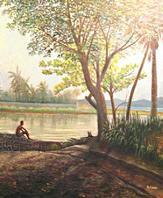
Henry Lowe's 'By The River'.
-Contributed photo
Sana Rose, Contributor
'JAMAICAN Landscapes' is the subject and title of Bolivar Gallery's latest exhibition.
Most of the exhibitors are well-known, seasoned artists who have been in the field for many years. All of them are painters Ralph Campbell, George Rodney, Judy Ann MacMillan, Michael Lester, John Wood, Henry Lowe, Andy Jefferson (also a printmaker), Glen Lawrence, Susan Shirley, Maxine Gibson, Barbara Juliet Thorburn and Kacey Ferguson. These artists are either specialists in the painting of landscapes or this subject forms a large part of their oeuvre. The wide-open
terrain of the Jamaican landscape in particular has captivated many painters beginning with the English itinerant artists in the 19th century up to the present.
These days, the Jamaican landscape is often over-ridden by people and buildings that have become the main subject of many paintings.
In the present show, the land shaped by God, man and
imagination are presented.
Semi-abstract renditions of the landscape are seen in George Rodney's signature style of rich colour and geometric shapes and the painted wood assemblages by Maxine Gibson.
Gibson, also an architect, seems to have merged both of her artistic interests and opted for an interpretation of the landscape that formally recalls the Synthetic Cubism explorations by Spanish artist Pablo Picasso. The other artists in the show remain purely representational. The artists' temperaments are seen and felt in the works: Judy Ann MacMillan's 'October' and, especially the late Ralph Campbell's 'Landscape with Houses' are created with swiftly applied strokes offering panoramic views.
On the other hand Rodney, Ferguson, Wood, Shirley, Lowe and Thorburn are far more calculated in their renditions. Thorburn increases the temperature of her colours while MacMillan makes use of complementary colours to add a bit of drama to the scene. Andy Jefferson infuses a little
fantasy with angels floating above a coastline and Glen Lawrence, while he may not have intended it, leaves us with a somewhat 'other worldly feel' due to the haziness of his piece, 'Newcastle'. From a representational standpoint, light is the most challenging aspect of the images, which is often inconsistent.
There is some incongruity with the theme of the show with regard to some of the pieces included and, at the same time the
curatorial intent is unclear. MacMillan is also represented
by two pastel works one of a tree and the other a section of a coastline. These pieces lack the richness of her sole oil painting and do not focus on the land.
'THE FOREST'
Michael Lester's work, 'The Forest' is spatially ambiguous and the effect of the landscape is lost to foliage while Henry Lowe's 'Cargil Lane' focuses mainly on the architectural
element of the picture so
much so that the land in the background is relegated to
secondary importance. For
the most part, the show does
not really present unique
interpretations of the landscape as subject matter or idea. We
are certainly presented with
different scenes but the idea that is supposed to hold this show together is uncertain. Were
these pieces brought together just because the land is the subject
or should we be taken to another level of contemplation about
this rather popular theme?
The exhibition continues.

